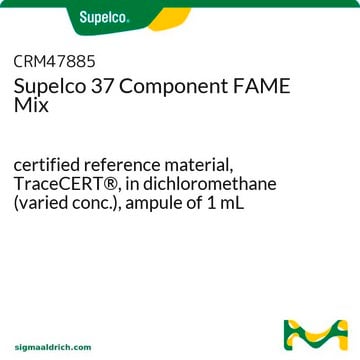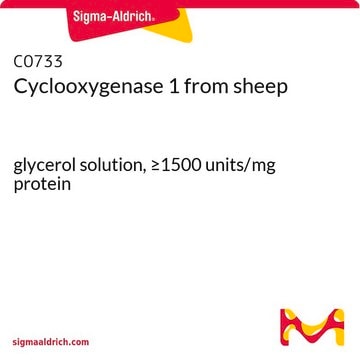If this product has an expiration or retest date, it will be shown on the Certificate of Analysis (COA, CofA). If there is no retest or expiration date listed on the product's COA, we do not have suitable stability data to determine a shelf life. For these products, the only date on the COA will be the release date; a retest, expiration, or use-by-date will not be displayed.
For all products, we recommend handling per defined conditions as printed in our product literature and website product descriptions. We recommend that products should be routinely inspected by customers to ensure they perform as expected.
For products without retest or expiration dates, our standard warranty of 1 year from the date of shipment is applicable.
For more information, please refer to the Product Dating Information document: https://www.sigmaaldrich.com/deepweb/assets/sigmaaldrich/marketing/global/documents/449/386/product-dating-information-mk.pdf
A3611
Acide arachidonique
from non-animal source, ≥98.5% (GC)
Synonyme(s) :
Acide cis,cis,cis,cis-5,8,11,14-eicosatétraénoïque, Acide eicosa-5Z,8Z,11Z,14Z-tétraénoïque, Immunocytophyte
Sélectionner une taille de conditionnement
126,00 $
Sélectionner une taille de conditionnement
About This Item
126,00 $
Produits recommandés
Source biologique
non-animal source
Niveau de qualité
Essai
≥98.5% (GC)
Forme
liquid
Indice de réfraction
n20/D 1.4872 (lit.)
pb
169-171 °C/0.15 mmHg (lit.)
Pf
−49 °C (lit.)
Densité
0.922 g/mL at 25 °C (lit.)
Groupe fonctionnel
carboxylic acid
Type de lipide
omega FAs
Conditions d'expédition
dry ice
Température de stockage
−20°C
Chaîne SMILES
OC(CCC/C=C\C/C=C\C/C=C\C/C=C\CCCCC)=O
InChI
1S/C20H32O2/c1-2-3-4-5-6-7-8-9-10-11-12-13-14-15-16-17-18-19-20(21)22/h6-7,9-10,12-13,15-16H,2-5,8,11,14,17-19H2,1H3,(H,21,22)/b7-6-,10-9-,13-12-,16-15-
Clé InChI
YZXBAPSDXZZRGB-DOFZRALJSA-N
Vous recherchez des produits similaires ? Visite Guide de comparaison des produits
Catégories apparentées
Application
<li><strong>Molecular Mechanisms Associated with the Inhibitory Role of Long Chain n-3 PUFA in Colorectal Cancer:</strong> This study discusses the effects of long-chain polyunsaturated fatty acids, like arachidonic acid, on colorectal cancer mechanisms. The research focuses on the anti-inflammatory and cancer inhibitory roles through the modulation of lipid metabolism and signal transduction pathways (Jayathilake et al., 2024).</li>
<li><strong>Zhilining Formula alleviates DSS-induced colitis through suppressing inflammation and gut barrier dysfunction via the AHR/NF-Bp65 axis:</strong> This article presents arachidonic acid′s role in the suppression of inflammation and restoration of gut barrier function, crucial for understanding inflammatory diseases and developing therapeutic strategies (Zhou et al., 2024).</li>
<li><strong>5,6-diHETE lactone (EPA-L) mediates hypertensive microvascular dilation by activating the endothelial GPR-PLC-IP(3) signaling pathway:</strong> Explores the cardiovascular implications of arachidonic acid metabolites, specifically their role in microvascular responses, which could influence hypertension treatment strategies (Asulin et al., 2024).</li>
</ul>
Actions biochimiques/physiologiques
Conditionnement
Mention d'avertissement
Warning
Mentions de danger
Conseils de prudence
Classification des risques
Eye Irrit. 2 - Skin Irrit. 2
Code de la classe de stockage
10 - Combustible liquids
Classe de danger pour l'eau (WGK)
WGK 3
Point d'éclair (°F)
235.4 °F - closed cup
Point d'éclair (°C)
113 °C - closed cup
Faites votre choix parmi les versions les plus récentes :
Certificats d'analyse (COA)
Vous ne trouvez pas la bonne version ?
Si vous avez besoin d'une version particulière, vous pouvez rechercher un certificat spécifique par le numéro de lot.
Déjà en possession de ce produit ?
Retrouvez la documentation relative aux produits que vous avez récemment achetés dans la Bibliothèque de documents.
Les clients ont également consulté
-
How can I determine the shelf life / expiration / retest date of this product?
1 answer-
Helpful?
-
-
How is shipping temperature determined? And how is it related to the product storage temperature?
1 answer-
Products may be shipped at a different temperature than the recommended long-term storage temperature. If the product quality is sensitive to short-term exposure to conditions other than the recommended long-term storage, it will be shipped on wet or dry-ice. If the product quality is NOT affected by short-term exposure to conditions other than the recommended long-term storage, it will be shipped at ambient temperature. As shipping routes are configured for minimum transit times, shipping at ambient temperature helps control shipping costs for our customers. For more information, please refer to the Storage and Transport Conditions document: https://www.sigmaaldrich.com/deepweb/assets/sigmaaldrich/marketing/global/documents/316/622/storage-transport-conditions-mk.pdf
Helpful?
-
-
What is the solubility of item A3611, Arachidonic acid?
1 answer-
This product is soluble in DMSO (100 mg/ml), DMF (100 mg/ml), 100% ethanol (50 mg/ml), methanol (50 mg/ml), chloroform (50 mg/ml), dichloromethane, hexane, acetonitrile, and ether.
Helpful?
-
-
what is the volume in the 10mg ampule for A3611- arachidonic acid?
1 answer-
Based on the density of 0.922 g/mL, the volume of the 10 mg package is approximately 0.011mL.
Helpful?
-
-
What is the volume in microL of arachidonic acid (A3611-100 mg) in vial? Please specify the purity (PCode 1003455023).
1 answer-
There is 108 uL in the 100mG pack size. The exact purity will be listed on the Certificate of Analysis. Please see the sample Certificate of Analysis: https://www.sigmaaldrich.com/certificates/sapfs/PROD/sap/certificate_pdfs/COFA/Q14/A3611-1G-PWSLCQ3577.pdf
Helpful?
-
-
May I know the Molarity (M) of the Arachidonic Acid A3611? It was not stated in the SDS.
1 answer-
The concentration for this product will be lot specific as purity changes with each batch. The concentration of this material can be calculated by the following equation: density x 1000 x purity percent divided by the molecular weight. For example, lot SLCQ3577 on the sample certificate of analysis will have a concentration of about 3.01 M
Helpful?
-
-
Hi, I'm used to ordering AA with this same catalogue nr at 10mg in powder form. Now only 100mg in liquid form is available. In which solvent is this?
1 answer-
This is pure arachadonic acid - it is not in any solvent. Its melting point is at -49 deg C. At temperatures above, it will be in its liquid physical state. You can determine the amount by using the density for a calculation. 0.922 g/mL at 25 °C (lit.)
Helpful?
-
Active Filters
Notre équipe de scientifiques dispose d'une expérience dans tous les secteurs de la recherche, notamment en sciences de la vie, science des matériaux, synthèse chimique, chromatographie, analyse et dans de nombreux autres domaines..
Contacter notre Service technique










